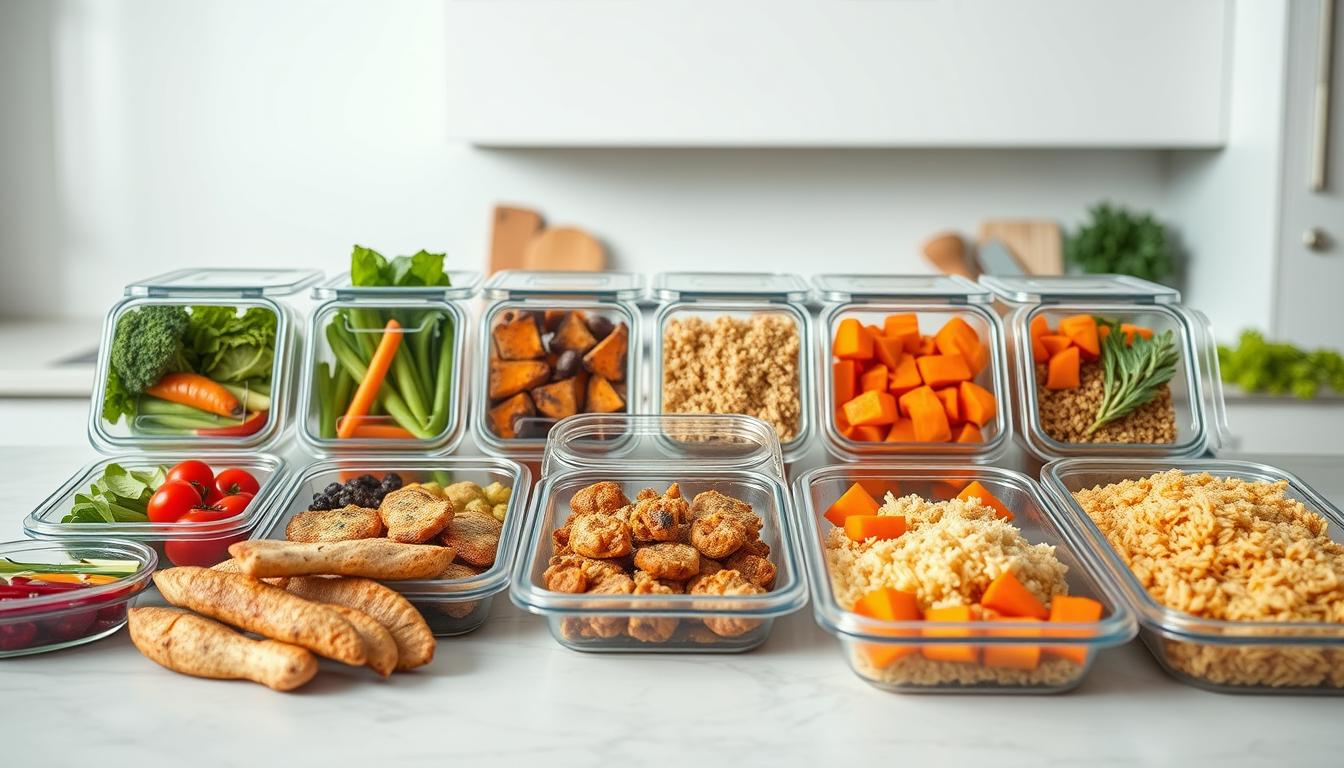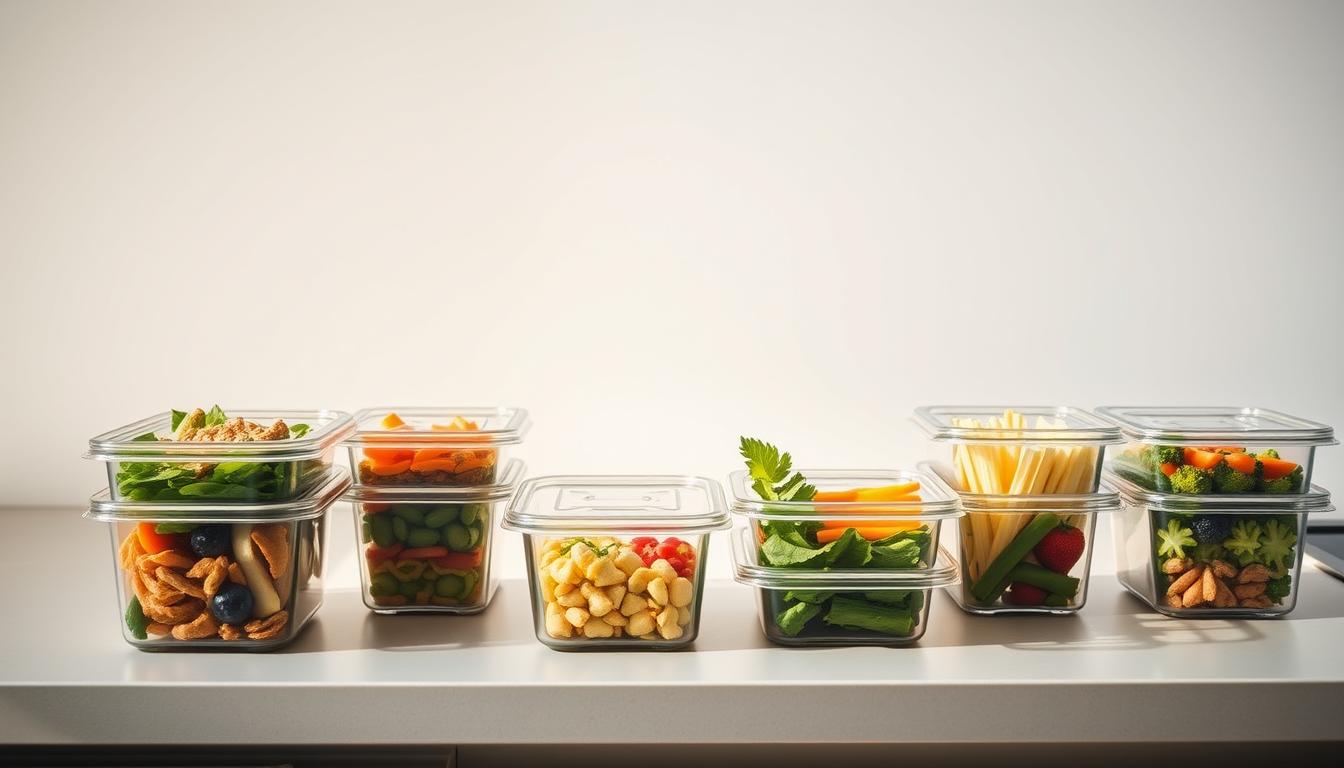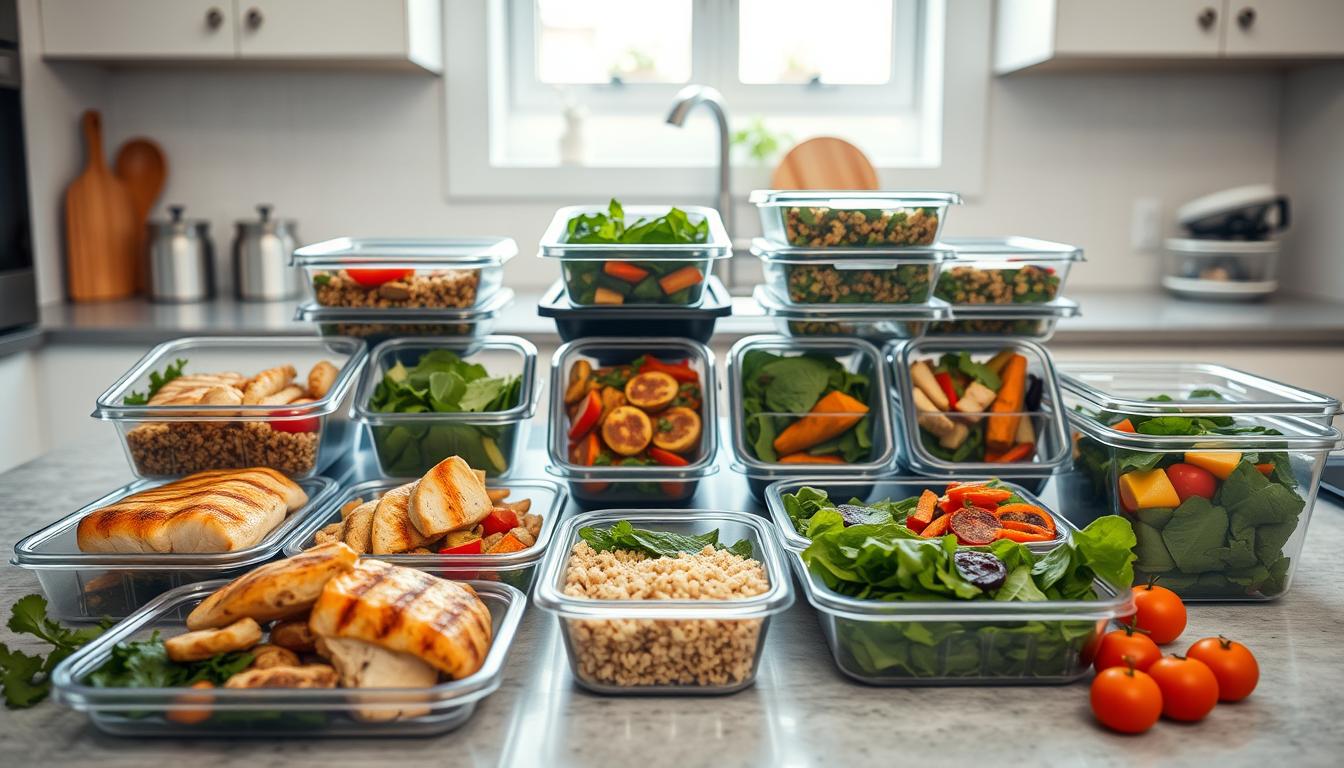Meal Prep Hacks to Achieve Your Weight Loss Goals
Embarking on a weight loss journey can be challenging, but with the right strategies, achieving your goals becomes more manageable. One effective approach is meal preparation, a technique that involves planning and preparing your meals in advance. This not only saves time but also helps in making healthier dietary choices.

By adopting meal prep hacks, you can streamline your path to a healthier you. This article will guide you through the process, providing you with practical tips and insights on how to effectively plan your weight loss meal planning. Whether you’re a beginner or looking to refine your existing routine, our comprehensive guide has got you covered.
Key Takeaways
- Understand the importance of meal prep in achieving weight loss goals.
- Learn how to plan and prepare healthy meals in advance.
- Discover practical meal prep hacks to simplify your weight loss journey.
- Gain insights into effective weight loss meal planning strategies.
- Find out how meal prep can help in making healthier dietary choices.
Why Meal Prep Is Essential for Weight Loss Success
Achieving weight loss success requires a strategic approach, and meal prep is a crucial element in this journey. By planning and preparing meals in advance, individuals can take control of their dietary habits, fostering a healthier relationship with food.
The Science Behind Planned Eating and Weight Management
Planned eating, facilitated by meal prep, is grounded in the science of nutrition and psychology. It helps regulate calorie intake and supports weight loss strategies by ensuring that the body receives the necessary nutrients. Research indicates that individuals who plan their meals tend to have better weight management outcomes.
How Meal Prepping Prevents Impulsive Eating Decisions
Impulsive eating decisions often derail weight loss strategies. Meal prepping mitigates this by providing healthy, pre-prepared meals, thus reducing the likelihood of resorting to unhealthy, convenient foods. This proactive approach to eating supports a balanced diet and aids in maintaining a calorie deficit, crucial for weight loss.
| Benefits of Meal Prep | Impact on Weight Loss |
|---|---|
| Structured Eating Plan | Supports calorie control and nutrient balance |
| Reduced Impulsive Eating | Minimizes unhealthy food choices |
| Time Efficiency | Allows for more effective daily planning |
By incorporating healthy meal prep and meal prep tips into daily routines, individuals can significantly enhance their weight loss efforts, setting themselves up for long-term success.
Getting Started: Essential Tools and Equipment
Starting your meal prep adventure requires some basic yet vital equipment. Having the right tools can streamline your process, making healthy eating more efficient and enjoyable.
Portion-Controlled Containers for Weight Management
Investing in portion-controlled containers is a game-changer for weight management. These containers help in measuring out the right amount of food, reducing food waste, and keeping your meals organized. Look for containers that are microwave-safe, dishwasher-friendly, and BPA-free.
Time-Saving Kitchen Appliances Worth the Investment
Certain kitchen appliances can significantly cut down your meal prep time. A slow cooker, for instance, allows you to prepare meals that simmer all day, while a food processor can chop, slice, and puree ingredients in minutes. Consider investing in a multi-cooker or an Instant Pot for versatile cooking options.
Budget-Friendly Alternatives for Beginners
Starting out with meal prep doesn’t have to break the bank. Opt for budget-friendly alternatives like reusable silicone bags instead of plastic containers, or a simple chef’s knife instead of specialized gadgets. You can also repurpose jars and containers you already have at home.
By equipping your kitchen with these essentials, you’ll be well on your way to making meal prep a sustainable part of your healthy eating routine.
Smart Meal Planning Strategies for Weight Loss
Effective weight loss isn’t just about dieting; it’s about adopting smart meal planning strategies that promote sustainable eating habits. By planning your meals in advance, you can ensure you’re consuming the right balance of nutrients to support your weight loss goals.
Calculating Your Caloric Deficit for Effective Weight Loss
To lose weight, you need to create a caloric deficit by consuming fewer calories than your body burns. A safe and sustainable rate of weight loss is 1-2 pounds per week, which typically requires a daily caloric deficit of 500-1000 calories.
Balancing Macronutrients for Optimal Fat Burning
A balanced diet that includes the right mix of protein, healthy fats, and complex carbohydrates is crucial for optimal fat burning. Aim for a macronutrient breakdown that supports your weight loss goals.
| Macronutrient | Recommended Daily Intake |
|---|---|
| Protein | 1.6-2.2 grams per kilogram of body weight |
| Healthy Fats | 0.5-1 gram per kilogram of body weight |
| Complex Carbohydrates | 2-3 grams per kilogram of body weight |
Creating a Weekly Meal Calendar That Prevents Boredom
To keep your meal prep interesting and prevent boredom, create a weekly meal calendar that includes a variety of healthy meals. You can use meal prep containers to portion out your meals and make them easy to grab on the go.
Meal Prep for Weight Loss: Step-by-Step Guide
Transform your weight loss efforts with a step-by-step meal prep guide that makes healthy eating easy and accessible. Meal prep is a game-changer for those looking to lose weight, as it helps you stay on track with your dietary goals and avoid last-minute, unhealthy food choices.
Preparing Lean Proteins in Bulk
Start by preparing lean proteins like chicken, turkey, and tofu in bulk. These protein sources are not only low in fat but also rich in nutrients. Cooking in bulk saves time during the week and ensures you have healthy protein ready to go. Grill, bake, or sauté your proteins with a variety of spices to keep things interesting.

Batch Cooking Complex Carbohydrates That Keep You Full
Complex carbohydrates like brown rice, quinoa, and sweet potatoes are filling and provide sustained energy. Batch cooking these foods allows you to have a steady supply of healthy sides that complement your protein. Try roasting or boiling a large batch of complex carbs at once to save time.
Prepping Vegetables for Maximum Nutrition and Minimal Calories
Vegetables are a crucial part of a weight loss diet, providing essential vitamins and minerals while being low in calories. Prep a variety of vegetables like broccoli, spinach, and bell peppers by washing, chopping, and storing them in airtight containers. This makes it easy to add them to your meals throughout the week.
Making Healthy Sauces and Dressings Without Hidden Calories
Store-bought sauces and dressings can be high in hidden calories and unhealthy ingredients. Making your own sauces and dressings from scratch allows you to control the ingredients and calorie count. Use healthy bases like Greek yogurt, avocado, and olive oil to create delicious and nutritious condiments.
Time-Saving Techniques for Busy Schedules
Squeezing meal prep into a hectic lifestyle is possible with a few clever hacks that save time without compromising nutrition. For individuals striving to achieve their weight loss goals, incorporating efficient meal prep strategies is crucial.
One effective approach is The 2-Hour Sunday Method, which involves dedicating just two hours on Sunday to prepare meals for the entire week. This method allows you to cook in bulk, portion out your meals, and store them appropriately, ensuring you have healthy meals ready to go.
The 2-Hour Sunday Method for Week-Long Success
This method is straightforward: plan your meals, shop for ingredients, and then spend two hours cooking and portioning. It’s an efficient way to ensure you’re eating healthy, weight loss-friendly meals throughout the week.
Freezer-Friendly Meal Options That Support Weight Loss
Preparing meals that freeze well is another time-saving strategy. Consider making large batches of soups, stews, or casseroles that can be frozen in individual portions. Some examples include:
- Lean beef or turkey chili
- Vegetable and bean stew
- Grilled chicken or vegetable stir-fry
Semi-Homemade Shortcuts That Don’t Sacrifice Nutrition
Sometimes, using pre-cut or pre-cooked ingredients can save a significant amount of time. Look for pre-washed greens, pre-cut vegetables, or pre-cooked lean proteins to streamline your meal prep process. Just be mindful of the nutritional content and avoid products with added preservatives or excessive sodium.
By implementing these time-saving techniques, you can maintain a healthy meal prep routine even on the busiest of days, supporting your weight loss journey and overall well-being.
Weight-Loss Friendly Recipes for Meal Prep Beginners
Starting your meal prep journey can be daunting, but with the right recipes, achieving your weight loss goals becomes much simpler. Meal prep is an effective way to control your calorie intake and ensure you’re eating nutrient-dense meals. Here, we’ll explore some delicious and healthy recipes perfect for beginners.
Breakfast Options Under 300 Calories
Breakfast is an essential meal to prep for weight loss. Try making overnight oats with almond milk, chia seeds, and fresh berries. This meal is not only under 300 calories but also packed with fiber and protein.
Another great option is scrambled eggs with spinach and whole-grain toast. This protein-packed breakfast will keep you full until lunchtime.
Protein-Packed Lunches That Keep You Satisfied
For lunch, consider prepping grilled chicken breast with quinoa and steamed vegetables. This meal is high in protein and fiber, making it very satisfying.
Alternatively, you can make a salad with canned tuna, mixed greens, and a variety of vegetables. Top it with a homemade vinaigrette for a healthy and filling meal.
Low-Carb Dinner Ideas That Prep in Minutes
Dinner can be as simple as prepping a large batch of grilled salmon with roasted vegetables. This low-carb meal is rich in omega-3 fatty acids and antioxidants.
Another quick option is zucchini noodles with turkey meatballs. This low-carb dinner is not only delicious but also easy to prep in advance.
Portion Control Tips for Each Recipe
To maintain portion control, use a food scale to measure your ingredients. For example, aim for 3.5 ounces of protein per serving.
Divide your prepped meals into individual containers to avoid overeating. This will also make it easier to grab a healthy meal on the go.
| Meal | Calories | Protein |
|---|---|---|
| Overnight Oats | 250 | 20g |
| Grilled Chicken Breast | 350 | 40g |
| Zucchini Noodles with Turkey Meatballs | 300 | 30g |

Overcoming Common Meal Prep Challenges
Successfully navigating meal prep for weight loss requires overcoming a few common hurdles. Meal prep is a powerful strategy for achieving weight loss goals, but it can be challenging to maintain consistency.
Dealing with Food Fatigue and Cravings
One of the primary challenges is food fatigue, which occurs when you get tired of eating the same meals repeatedly. To combat this, incorporate variety into your meal prep by trying new recipes and rotating ingredients. Additionally, be mindful of your cravings and have healthy alternatives ready.
Adapting Your Meal Prep to Social Situations
Social situations can also pose a challenge. When eating out or at social gatherings, plan ahead by checking menus in advance or bringing a healthy dish to share. This way, you can stay on track with your weight loss goals without feeling deprived.
Staying Consistent During Holidays and Travel
Holidays and travel can disrupt even the best-laid meal prep plans. To stay consistent, pack healthy snacks and research healthy dining options at your destination. By being prepared, you can maintain your weight loss momentum even when your routine is disrupted.
Conclusion
By incorporating meal prep into your daily routine, you can achieve your weight loss goals and develop a healthier relationship with food. Effective weight loss meal planning is about more than just cutting calories; it’s about creating a balanced diet that nourishes your body.
With the meal prep hacks and strategies outlined in this article, you’re equipped to take control of your eating habits and make healthy eating a sustainable part of your lifestyle. Whether you’re a busy professional or a fitness enthusiast, meal prep for weight loss can be tailored to suit your needs and preferences.
By dedicating a few hours each week to meal prep, you can save time, reduce food waste, and enjoy a variety of delicious and nutritious meals. So, start planning your meals, get cooking, and watch your weight loss journey unfold with confidence.
FAQ
What is meal prep, and how does it aid in weight loss?
Meal prep, or meal preparation, involves planning, shopping, cooking, and portioning meals in advance. It aids in weight loss by ensuring healthy eating, reducing impulsive food choices, and controlling calorie intake.
How do I start meal prepping for weight loss?
To start meal prepping, begin by planning your meals, making a grocery list, and shopping for ingredients. Invest in portion-controlled containers and time-saving kitchen appliances. Start with simple recipes and gradually experiment with new dishes.
What are some essential tools for meal prep?
Essential tools for meal prep include portion-controlled containers, a slow cooker, Instant Pot, or other time-saving kitchen appliances. You may also need a meal planning app, a kitchen scale, and a set of sharp knives.
How do I calculate my caloric deficit for weight loss?
To calculate your caloric deficit, determine your daily maintenance calories and then reduce that number by 500-1000 calories to promote weight loss. You can use an online calorie calculator or consult with a registered dietitian for a personalized assessment.
What are some healthy meal prep recipes for weight loss?
Healthy meal prep recipes for weight loss include lean protein sources like chicken, turkey, and tofu, complex carbohydrates like brown rice and quinoa, and a variety of vegetables. You can also prep healthy sauces and dressings to add flavor to your meals.
How do I deal with food fatigue during meal prep?
To deal with food fatigue, vary your meal prep recipes, incorporate new ingredients, and try different cuisines. You can also meal prep with a friend or family member to stay motivated and inspired.
Can I meal prep on a budget?
Yes, meal prep can be budget-friendly. Plan your meals around seasonal produce, buy in bulk, and use affordable protein sources like beans and lentils. You can also repurpose leftovers to reduce food waste.
How do I stay consistent with meal prep during holidays and travel?
To stay consistent with meal prep during holidays and travel, plan ahead, pack healthy snacks, and research healthy dining options at your destination. You can also prep meals that can be easily reheated or consumed on-the-go.
